Interview: Britt Raes Discusses Charming Second Short Film “Luce and the Rock”
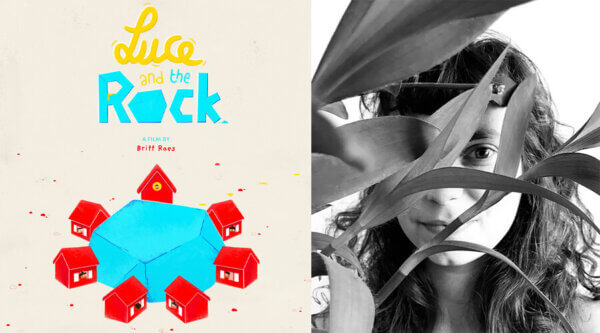
Luce and the Rock poster – and Britt Raes (photo copyright: Dimitri De Keukelaere)
Over 5 years later, and Britt has just wrapped up production on her second short film – Luce and the Rock. The 2D animation tells the story of two unlikely friends who, although they seem to have nothing in common, end up facing their fears together. In the film, Britt tackles the theme of the fear of the unknown towards a wide audience (4 years and over).
The short – co-produced by Thuristar, La Cabane Productions, and Studio Pupil – will receive its world premiere in Berlin this month at The Berlinale; taking part in the Generation KPlus competition which brings together films that “take young people seriously”.
We were pleased to catch up with Britt again, and find out more about her latest production…
We last spoke to you in 2017, after your short film Catherine, was blitzing its way around the festival circuit. Can you tell us what you have been up to in the last 5 years?
I was travelling around with Catherine quite a lot for 2 years. What a joy to see so many places I otherwise might not have visited! Taiwan, Russia, UAE, USA,… I feel so lucky, as a few years later a pandemic would keep us all at home!
The last 5 years lots of non-work related (family and relationship) issues took my time and energy, mentally and practically. Everyone has baggage, of course. But dealing with it did slow down the process for Luce and the Rock I guess. I made the first draft of the storyboard back in 2017, but only in 2021 we actually went into production.
Luce and the Rock is part of a bigger concept – The Lovely Land – that includes more stories for kids I’ve been writing the last years. I want to make a book and more animated content with all those stories.
Besides that, I’ve also been developing a series for adults, doing commissioned work every now and then, and teaching at KASK.
You started work on the film back in 2016; could you tell us how did you come up with the idea and how you developed the story?
I started drawing these 2 characters, big and small, a tiny girl and a giant creature. I’m quite short myself, so it’s a contrast I find fascinating.
Another inspiration is my fear of the dark. As an adult I can still feel it and it brings out this primary childlike fear. Whenever I’m in a room that is truly dark I can physically feel uncomfortable. There is no reference to where things are and I become very aware of my other senses. I wrote the story myself, inspired by the vibe of fairytales and folktales. But I didn’t want to have a ‘good guy/bad guy’ type of story. There is no right or wrong, just different characters who experience the same world in a different way. Moralistic judgements encourage violence and I want to stimulate a different way of thinking in the stories I create.
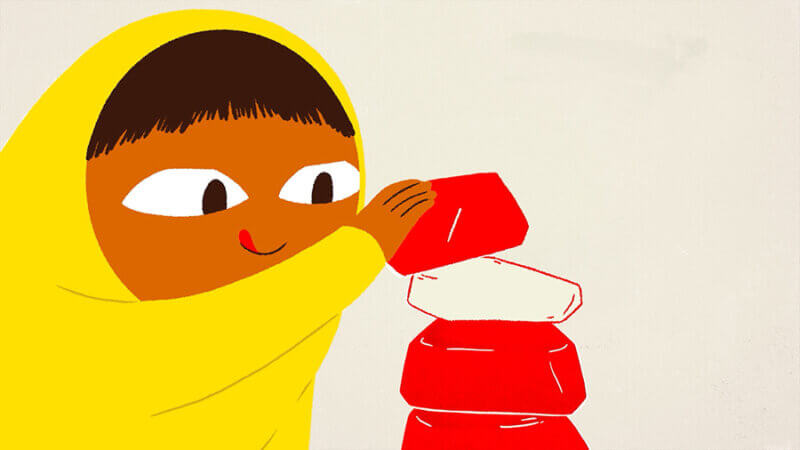
I also didn’t want to feature a princess or a king as a protagonist, but to show very common people in a very common world, living a very common life. I used very relatable archetype story elements, making the mundane magical.
A lot of your work carries a very distinct, vibrant, colourful aesthetic – from Catherine to your commercial work and illustrations. Could you tell us how you developed the visual style for this film?
I like to think about how the visual style of a film can enhance the story. I was drawn to primary elements, in shape and emotion and colour, to create a world that is easy to get drawn into. Yellow, red, blue. Sun and moon, light and dark. Square, circle, triangle. House, mountain, lake, rocks. Wind, water, land.
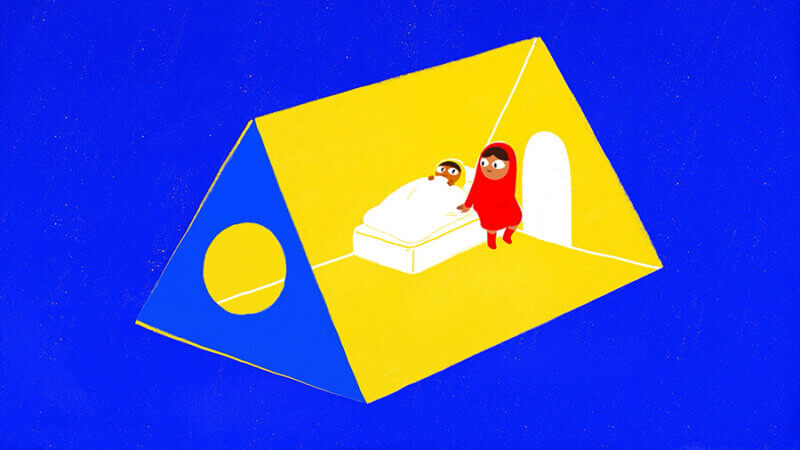
It’s very basic, the world is stripped of anything that does not serve the story. I like to do that to make the world very relatable for the viewer. A visual style that is so simple might look technically easy, but it comes with its own challenges because there is nowhere to hide.
You had three co-production partners, in Thuristar, La Cabane Productions, and Studio Pupil – could you tell us what each partner brought to the project and how you worked with them?
Thuristar got on board first as the main producer. They have been on this journey with me and Luce since 2018. They have been so supportive in each step, the film would not be what it is without them. I got the space and time to develop it as an independent movie, but had their professional expertise to lean on. They helped me look for what the project needed and what I wanted as a director, and then made sure it was there for me. I got lots of love and professional support; all I could dream of. But they also surpassed my dreams, managing to get partners on board like Ketnet and RTBF before the film was even finished.
I have known Tünde from Studio Pupil for years as a friend, so when the opportunity came to get her involved, I took it with both hands! The team in the Netherlands gave extra touches to the visual style; doing finishing work on the backgrounds, animating part of the VFX and cleaning/colouring the animation. And of course, the music and sound design comes from the mind of Bram Meindersma!
La Cabane Productions also supported in different ways. They were amazing help with the overall production management, assistant editing and they took care of the French dubbing. And thanks to them France Télévision joined!
I also want to give a shout-out to Studio Enclume, where I did a writing residency (before any producer was involved yet). This jump started the project!
Luce and the Rock appears to cast a range of diverse characters; both for the main and background characters. Can you tell us how you approached diversity; both in the film and the within production team?
It’s something I was not very conscious about for my previous short film Catherine, and I really wanted to make mindful decisions about it this time. Diversity pops up in the film in different ways. It’s just part of the world, because that’s also how it is in real life.
Mom and Luce have different skin tones, and the Villagers go from pink to dark brown. I wanted to have a strong young child character with a darker skin tone as a main protagonist. Some of the Villagers have buns, and some do not, and that doesn’t indicate whether they are male or female.
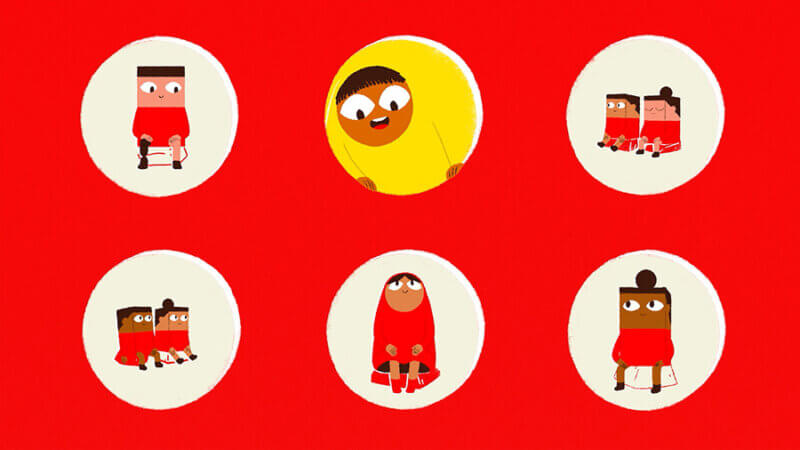
There is also one Villager with a ‘fake leg’. A previous housemate of mine has a prosthetic leg, and he has a 2½ year old daughter. It’s my gift to her, I wanted her to have a film where she can see someone just like her dad, being part of this world just like all the other characters. I’m very curious how many people will notice the leg. It’s quite subtle, which was a conscious choice.
Diversity is all around us. For the crew we were also hoping for a balanced team, and I was very happy it happened very organically. People were hired because they felt like the right people for the job and because they were very enthusiastic to work on the film. The talent in the team are a mix of people that have roots in different places in the world: China, Turkey, France, Belgium, Philippines, Netherlands, Japan.
What were your influences and inspirations for this film; both thematically and aesthetically?
There are different cultural elements coming together. Old fairy tales and folktales originate from a specific culture or region, but I certainly did not want to reference just one culture. I don’t think that’s really possible anymore, because our current world is a world where different cultures blend, and so does my inspiration.
So this story is a ‘modern tale’ instead of a ‘fairy tale’ or ‘folktale’. Luce and her mom wear a sort of cloak as clothing. Some people might interpret it as a chador or khimar. My inspiration is actually a mixture between a dress and a cape/hoody like ‘little red riding hood’. But I like that people interpret it in a different way, and that they can see their own cultural references represented.
The music of the film has Eastern-European vibes, but is actually inspired by a Finnish polka song which was based on a Russian folk song.
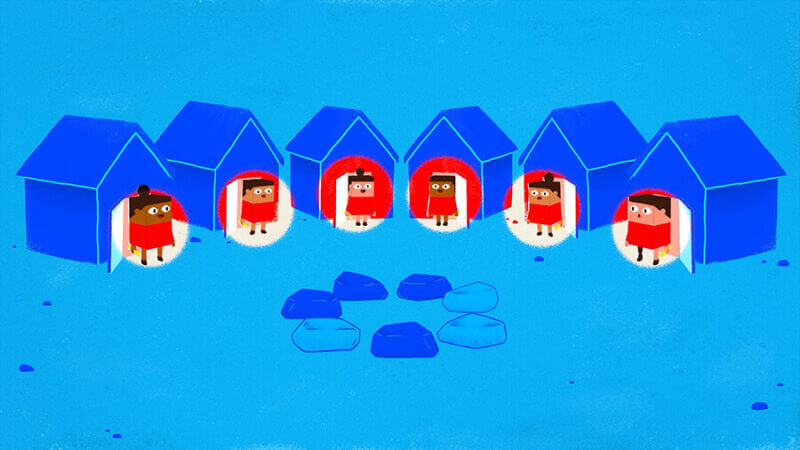
I’ve had the pleasure to travel to different parts of the world, so the landscapes in the movie reference so many different places. I saw all those mountains on my travels in the Austrian Alps, the south of Italy, Taiwan or the national parks in the USA. The absence of trees reminds me of my trip to Iceland. The wind blowing across the land brings me back to Wellington and Iceland. The houses being glued together is inspired by Kintsugi, the Japanese art of repairing broken pottery with gold. It’s a symbolic way to say that the village has become an even more beautiful and stronger place in the end, with the Rock Creature now being part of it.
Having completed the film in January 2022, a large chuck of production must have been produced during the pandemic and lockdown. How did this affect the making of the film?
The pandemic started when the film was in pre-production. At this moment the team was still quite limited, and I didn’t really mind working from home. It didn’t really affect the way I would have worked if there wasn’t a pandemic.
A year later the film went into real production. I had very much been looking forward to sitting together in a studio with the team, but the pandemic was still going strong. We didn’t want to postpone as we had no idea how long the situation would last. And because the film is digitally hand drawn, working remote was possible.
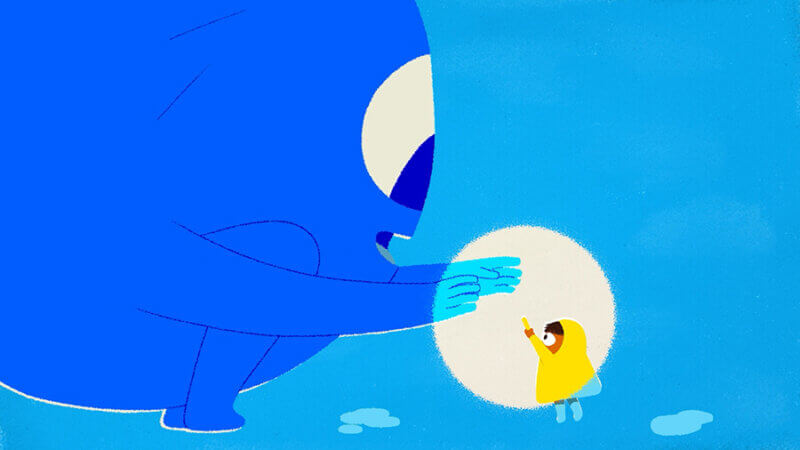
But doing so much remote work took its toll. I found it very challenging to direct remotely, direct people I had sometimes not even met in real life! I found it hard to communicate my intentions, to explain things through video chats or written notes felt very uneasy. This resulted in me delegating less work and trying to ‘fix’ a lot myself, which really weighed on me. And instead of asking for help, I just kept on working. I learned a lot about myself, how I want to direct, and how important communication and real contact is to me. I feel very grateful that the people involved were all so kind and patient and understanding and talented and a joy to work with! I could not have pulled through the process without them!!!
Now that Luce and the Rock is out there in the world, what will you be working on next?
There are several projects waiting and I look forward to diving into them! I want to make a children’s book based on the movie. A book has a different kind of magic to me than a movie. You tell the same story in a different way and the reader has more control on the rhythm of their experience. I’m curious to translate Luce’s story on paper. And of course, I hope to travel around the world together with Luce and the Rock!
And I have a bunch of other ‘modern tales’ in my mind that I want to develop into books and/or animated movies. I’ve already started writing some because they are itching in my fingers!
I am also writing an animated series for adults, about pet lovers! A bit edgy, with dark humour. This year I will sit together with a lovely scriptwriter and comic artist to create some stories. It’s a collaboration I am very excited about!
Upcoming screenings of Luce and the Rock include the ‘Generation KPlus’ section of The Berlinale (10-16th February), and the ‘Short Films for Young Audiences’ category at Anima Brussels (26 Feb – 6 Mar).
To find out more about what Britt Raes is up to, and to check out her work, you can follow her on: Tumblr, Vimeo and Twitter.

